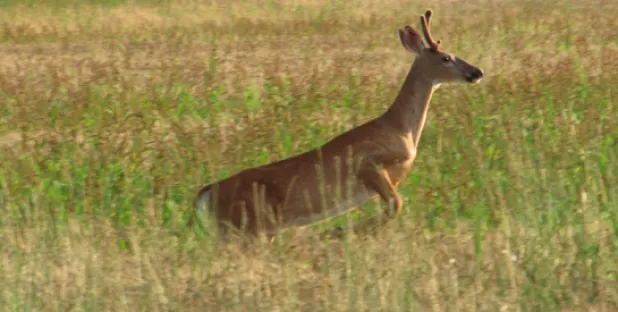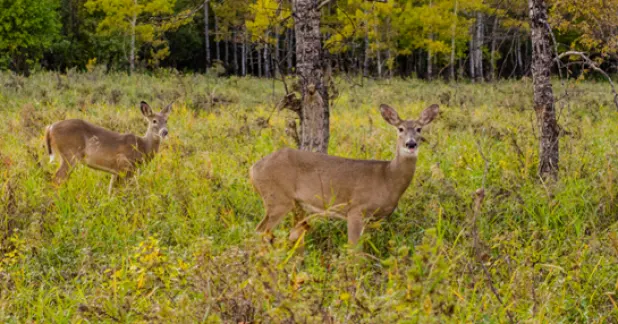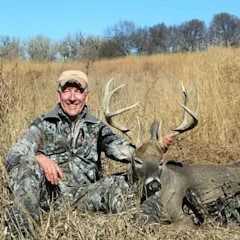One of the seven tenets of the North American Model of Conservation is that wildlife policy should be dictated by science, and hunters are the principal tool biologists use to manage deer. This is what my Wildlife Management 101 professor called the happy triangle: trained biologists, whitetails, and sportsmen.
In the real world, it’s more like a dysfunctional decahedron, with special-interest groups, lobbyists, legislators, governors, biologists, and factions of hunters all pulling in odd directions, often behind closed doors. At the ground level, it’s a messy, sometimes dirty business where money, power, and influence can matter as much as or more than what biologists prescribe, what hunters want, or what’s best for the deer.
Backroom Deer Deals
State agencies are supposed to manage deer herds on behalf of the public. That includes everyone—farmers, insurers, hunters, nonhunters, and even antis. But hunters are unique in this mix. Unlike any other group, we do the actual work—and we pay for it with license fees and excise taxes on equipment. Everyone should have a seat at the table to help bring consensus. But when hunters are left out, there is something fundamentally wrong.
At the same time, legislatures are supposed to hold DNRs accountable for science-based management, which means biologists must have data to justify their proposals. “Things go haywire, however, when the legislature or governor make their own decisions with no scientific data to back them up,” says former New Hampshire deer biologist Kip Adams of the Quality Deer Management Association. “This happens all the time, and it is entirely unjustifiable.”
In short, deer management should be a combination of science—guided by trained biologists and ensured by the legislature—and the will of the public, ironed out through a democratic process in which everyone has a vote and a voice. By all accounts, however, the influence of hardball politics and backroom deals is at an all-time high in deer management. “These days,” says Adams, “politics governs everything.”
The Doe Stops Here
In many states, the person with the most power to influence deer policy has typically never taken a wildlife management course, has perhaps never been hunting, and may even be openly hostile to hunters: the governor. He commonly appoints or approves the head of the wildlife agency or the board of commissioners, which oversees the agency chief. A governor who wants to take charge can usually do so.
In Iowa, hunters have been aggressively slashing doe populations for years at the request of the DNR, which had deemed the herd overpopulated. And unlike sportsmen in some other states, Iowans have done this without a fuss. But now, many hunters say there aren’t enough deer to make hunting worthwhile. They would like the DNR to issue fewer doe permits so they can start seeing more deer.
“As a group, we are rarely reluctant to shoot does,” says Sam Collora, 62, who owns the American Outdoors hunting shop in Mount Pleasant and has hunted the state since boyhood. “Lately, though, it’s become clear that we’ve done too good of a job. Right now we’re treating deer like vermin, and that’s a pretty pathetic view of the resource. So we’d like to see a change.” And the DNR wants to help. With deer populations in 80 percent of the state’s counties at or under goal, the DNR’s desire to reduce doe permits certainly appears reasonable.
And yet the doe-permit quotas have not been significantly reduced.
Hawkeye State deer biologist Tom Litchfield says that while his department can recommend changes to the state’s deer hunting regulations, they must now receive permission from Gov. Terry Branstad’s office. “Previously our recommendations would be reviewed by the Natural Resources Commission and then be put up for public review,” he says. “Now they go directly to the governor’s office, and if the folks there decide to hold our proposals up, it’s like they no longer exist. The public doesn’t even know about them.”
“I am surprised to hear that the DNR has been recommending fewer antlerless permits,” says Collora. “Like most hunters, when things go wrong, I assume the agency is to blame.”
Rather, it is the state’s powerful farm lobby, whose constituents want even fewer deer to prevent crop damage, and whose donors contributed $246,800 to Gov. Branstad’s 2010 campaign (according to followthemoney.org and opensecrets.org), that is standing in the way.
In 2008, the Iowa state legislature formed a Deer Study Advisory Committee designed to closely examine the state’s management program. There were representatives from the Farm Bureau, the transportation commission, the insurance institute, the nursery association, forestry professionals, the Sierra Club, and sportsmen’s groups. “Our department presented a plan to reduce deer numbers via antlerless quotas,” explains Litchfield. “Everyone agreed that our goals were valid and that, if we reached them, everyone would be satisfied.” The process took months of hard work but was a prime example of consensus reached the right way.
But when those goals were largely achieved in 2010, the farm lobby effectively said: Not good enough. They lobbied the new governor to further thin the herd.
“By then we were looking to stabilize deer numbers by reducing the antlerless harvest and to maintain a quality hunter experience,” says Litchfield. But in March 2011, before antlerless quotas could be cut, Gov. Branstad, who was unavailable for comment, issued Executive Order 71, stating that any proposed regulation that might cause an “unnecessary burden” to industry must be approved by his office. In Aug. 2012, Executive Order 80 established “stakeholder groups” to “protect the public” from “overregulation.” But the DNR is not represented. “The last stakeholder group meeting—a one-day event with little chance for discussion or compromise—occurred last winter, and I wasn’t invited,” Litchfield says. Meanwhile, his department has asked for reduced antlerless quotas for 40 counties and has received approval for only six.
“It’s just sad because in the original task force we could sit down, face each other, and have a discussion about deer populations,” says Litchfield. “That’s no longer the case.”
Don Brazelton, who is a part-time lobbyist for the Iowa Bowhunters Association and three other conservation groups, says pleading the hunter’s case at the legislature can seem futile. “The Farm Bureau has two full-time lobbyists at the capitol and brings in reinforcements as needed. They have a direct conduit to the governor, whereas I’m lobbying to individual legislators. I’m basically outgunned.” In short, he says, it boils down to money and votes, and the farm lobby controls more of both.
Ironically, the push to further thin deer herds may eventually backfire on the Farm Bureau and everyone else, says Litchfield. “You can only reduce a deer herd so much before hunting isn’t fun anymore. People decide they’ve had it and aren’t going to shoot does or, worse, they quit hunting altogether. Before long the deer herd will boom again, and who are you going to ask to knock it back then?”
Bucks in Gridlock
Meanwhile, trusting lawmakers to ensure that a state DNR’s proposals are science-based can be tricky, says Kip Adams, when some legislators refuse to accept the validity of science. “I won’t say who or where, but in a recent meeting, a legislator stood up and said, ‘Science is only one person’s opinion on something.’ He couldn’t have made a less true statement, and this person has a real impact on the state’s deer regs. That’s just wrong.”
The other problem with legislative bodies, for which there is no better example than today’s U.S. Congress, is gridlock.
In South Carolina, a large majority of hunters would like to see more mature bucks on the landscape. Again, the DNR wants to help them. But they’re stuck.
“We have virtually no management say-so when it comes to antlered deer—a fact that is lost on even our own hunters,” says South Carolina DNR deer program coordinator Charles Ruth, whose problem isn’t the governor but other politicians. “Buck quotas cannot be changed by our department without legislative approval.”
Palmetto State hunters currently have a 140-day rifle season that opens Aug. 15 and closes Jan. 1, during which they can each kill as many bucks as they want. In some areas, the herd has virtually no yearling-buck carryover. “We’d like to change these regs to improve the age structure of our buck herd, and surveys prove that over 70 percent of hunters agree.” The agency has had a list of recommendations before the legislature for three years, says Ruth, but every time a lawmaker starts to promote it, others representing a vocal minority of hunters derails it.
“It’s really become absurd,” he complains. “Under these rules, some hunters are killing 40 or more bucks every year. I can’t describe that as anything but selfish and more than a little bizarre in this day and age.”

Don’t Like it? Pass a bill
While the legislature blocks change in South Carolina, other states see special-interest groups or disgruntled hunters lobbying politicians to effect the changes they want, bypassing the DNR and sidestepping the democratic process.
The Wisconsin Conservation Congress (WCC) is a citizen advisory group that works with the DNR to craft everything from deer regulations to conservation policy. Established in 1934 by Aldo Leopold, the father of game management, the WCC is composed of elected representatives from each county who preside over annual meetings where any county resident is allowed to attend and vote on advisory questions. In short, everyone has a seat at the table. No backroom deals.
But for the Hunters Rights Coalition (HRC), a sportsmen’s group backed by state Safari Club International chapters, the Wisconsin Bear Hunters’ Association, and the NRA—which are good groups but not all-inclusive—the WCC’s process is too cumbersome.
“The Conservation Congress has done a lot of good, but they’re slow and they don’t always get it right,” says Greg Kazmierski, one of the HRC’s founders. “One problem sportsmen have is we tend to go for each other’s throats in public, and we often fail to unite on important issues. Our primary goal was to give hunters a political voice at the capitol, and we’ve learned that a handful of us from the groups we represent can hammer things out without the scrutiny of the media, then present a united front when we approach legislators.”
The HRC bypasses the WCC and goes directly to state legislators and the governor to promote change by statute. If you don’t like its position, Kazmierski says, you can try sending an e-mail. To its credit, the HRC has brought about some positive change, including a mentored youth hunting program. But the group is also pointed to as the spoiler of a bill that would have created a crossbow season for 2013, something many hunters wanted.
Among the HRC’s many critics is George Meyer, executive director of the Wisconsin Wildlife Federation and a former DNR secretary. “By any objective view they’ve been successful in the political arena,” Meyer says. “What they’re not concerned with is the scientific expertise of the DNR. And they’re frustrated by the slow, sometimes messy process of the Conservation Congress. Well, folks, welcome to democracy.” Meyer argues that healthy debate and compromise take time, but in the end you get a result most people can live with. He also says that the HRC is shortsighted—that when the pendulum of power shifts at the capitol, their system of jamming through change via influence could wind up badly for sportsmen. “They’re setting precedents that will likely come back to haunt us.”
In southeastern Minnesota, disgruntled hunters don’t need a well-backed group to pull the legislature into the fray. Here, as in South Carolina, the majority asked to see bigger bucks in the herd. Seventy percent of those surveyed by the DNR said they wanted some form of yearling-buck protection, and using antler-point restrictions (APRs) was the most popular choice among several options. Acting on this support, the DNR instituted a three-year trial period for APRs in 2009, vowing to continue them as long as the regulation met scientific goals and continued to have public approval.
But an angry minority of hunters marched to the state house and convinced Rep. Steve Drazkowski (R‑21B) to introduce a bill that would not only rescind APRs completely but also remove the DNR’s authority to set deer seasons without legislative approval. Though the bill was narrowly defeated, the state legislature required the DNR to receive its blessing before extending APRs beyond the trial period.
“It was frustrating to watch a single rogue legislator do something that defied logic and nearly undid years of consensus building,” says Jim Vagts, former president of the sportsmen’s group Bluffland Whitetails, which worked with the DNR for 14 years to help institute APRs. “It was also ironic. When we started trying to effect change to the state’s management policy, we had long, hard discussions about whether to work with the DNR in a process that gave a voice to all hunters or to go straight to a legislator. We decided that working with biologists instead of against them was the right way to do it.”
In the end, politics has always been and will continue to be a part of deer management. Governors will appoint department heads and commissioners. Legislatures will oversee DNR proposals. The question is: Will hunters, via our unique role as the doers and funders of deer management, maintain a strong voice in policy, or will we be muted by end runs and backroom deals? We will disagree on some particulars, no doubt. But we must come together to insist that deer policy be dictated by consensus, ironed out in the light of day, where we get the consideration we deserve.
_Photo CaptionsPhoto 1: Colby Stopa
Photo 2: spy cup
_


